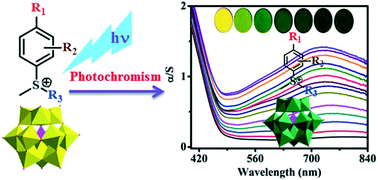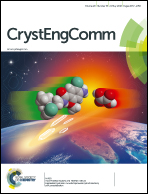Aromatic sulfonium polyoxomolybdates: tuning the photochromic properties through substitutions on the counter ion moiety†
Abstract
Development of new photoresponsive polyoxometalate hybrids is an active research area in recent years. Aromatic sulfonium counter ion based polyoxometalates are a relatively new class of materials having immense potential for structural and electronic fine-tuning. Continuing our studies on aromatic sulfonium polyoxometalates as tunable photochromic materials, herein we report four new aromatic sulfonium polyoxomolybdates, (DMTS)3[PMo12O40] (1), (MPDS)3[PMo12O40] (2), (HMPDS)3[PMo12O40] (3) and (BMPMS)3[PMo12O40] (4); where DMTS = dimethyl(p-tolyl)sulfonium, MPDS = (4-methoxyphenyl)dimethylsulfonium, HMPDS = (4-hydroxy-2-methylphenyl)dimethylsulfonium and BMPMS = butyl(4-methoxyphenyl)methylsulfonium. These hybrids were characterized by various analytical and spectroscopic techniques including ESI-MS and single crystal X-ray diffraction (hybrids 1, 2 and 4) analyses. Solid state studies revealed that these hybrids exhibit a color change from yellow to green or dark green under UV illumination and the photochromic properties exhibited by these hybrids can be fine-tuned by introducing various substituents on the counter ion moiety at multiple locations. The observed color change is due to the reduction of the Mo6+ centers of the cluster to Mo5+, as evidenced by EPR studies. The effects of various substitutions introduced on the counter ion moiety in determining the photocoloration speeds of the hybrids are discussed.



 Please wait while we load your content...
Please wait while we load your content...